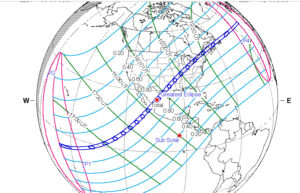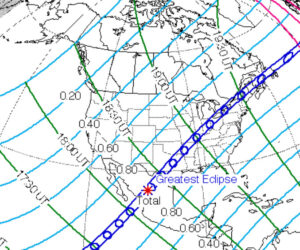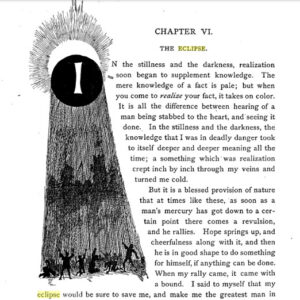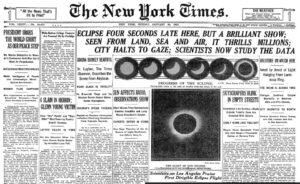
To prepare for the upcoming April 8, 2024 solar eclipse, semper paratis, I went to Recreational Equipment, Incorporated (REI) to pick up solar shade glasses that I bought on-line. This eclipse is forecast to be visible in Missouri — or more accurately termed opaque. The clerk, a lady, wore a girl scout vest replete with badges and lodge number. She was, however, not a girl scout and she was in snit and quite busy in her work. I humored her, and I engaged her in conversation. Her work came first, but we did talk about her last eclipse experience. It was way back seven years, in 2017. We shared in common a brief memory.
She was not very educated on eclipses or other astronomical phenomena. She was of the opinion that every eclipse is alike. That they all travel from West to East like the interstate — every eclipse goes from California to New York. Because that’s what happened in 2017. Must every eclipse rise in the west and set in the east?
I, of course, am fascinated by astronomy and to the point of coding astronomical ephemeris software. I told her that every eclipse is different. That this eclipse was going from the South West to the North East, from Texas to Maine. That was very confusing for her. I don’t think she like that idea particularly. And I am a long-haired, wild eyed kook who wanted to talk to her about eclipses. That was outside of her ‘comfort zone’.
But she did sell me eclipse glasses. Way over priced. But, kids don’t try this at home. Don’t want to get blinded by the sunlight. I am sure this happens to someone everytime.
I picked up the book, “Astronomy on your personal computer” almost forty years ago, when I was in graduate school working on my Ph.D. in Mathematics. Over the years, I translated the BASIC codes in that book, to more modern functional C/C++ codes. And from a Macintosh running System 7 to a GNU/Linux Toshiba laptop. I remember translating code, while I worked the night shift as an overnight security guard at the Las Vegas Convention Center in 2015. Really. Not much happens at two a.m. on the night shift. The doors were all locked. So there I was, hunched over a laptop trying to get astronomy codes to run.

Today, in 2024, I am still fighting the computer code compiler — I was getting a segmentation violation. The numbers don’t always agree with the examples in the book. But I managed to update orbtimes for another entry, another solar eclipse. It’s been almost seven years since I worked on it. It’s been almost seven years since I last worked on orbtimes, then was the Solar Eclipse of AUGUST 21, 2017. I originally called my code Startime, but I renamed it. I guess this will always be a work in progress, unfinished.
I have posted this 2.0 version to my Debian reflector. You can download and install with “apt-get install orbtimes“. For adding my Debian reflector site to your distribution list, Add
deb [ arch=amd64 ] http://apt.nick-strauss.com/apt/debian focal main
to your sources list. You can also refer to documentation at my orbtimes blog entries.
But it’s done. Finished. Updated. I released a new version — 2.0. Run as “orbtimes --selftest” or orbtimes --solar_eclipse.
My output listing:
SOLAR ECLIPSE APRIL 8, 2024 (45388.500000) 19.000000 -91.207250,36.622630
ELEVEN POINT STATE PARk
MOON UT=19.000000 POSITION AZ 206.066919 (206.100000) EL 58.527943 (58.500000) REF USNO
check: 1
AZ 206.066919 (206.100000) EL 58.527943 (58.500000) REF USNO
SUN AZ 206.062013 (206.100000) EL 58.524509 (58.500000) SHOULD MATCH MOON (SOLAR ECLIPSE)
check: 1
The position of the Sun and Moon for the place and date can be checked with the US Naval Observatory website:
US Naval Observatory calculation (USNO)
I have put in the solar eclipse calculations to the command line in my updated orbtimes version 2.0.
So, run as,
orbtimes -E --date="2024-apr-8" --location="38.6251N90.1868W"
at the location of the Gateway Arch in St Louis.
Output is,
Check: Solar eclipse possible. MUST be at new moon 45388.500000 == 45389.266410 (8.000000 4.000000 2024.000000)
argument latitude 0.033064 event day 45389.000000 event fraction 0.266410
Check: calculating solar eclipse on date 2024 4 8 and location -90.186800 38.625100
moon_lat 0.033064
eclipse probability 1.000000 at UT time 18.984448
The numbers 45388.5 is the Julian Day number referenced from 1900. Note that each Julian day starts at noon=0.5. The argument of latitude is from nutation, and is the lunar latitude. The closer this number is to zero, the higher the probability of an eclipse. I calculate a probability of 1 — the event is certain.
I calculate the event time of 18.984448 UT which is universal time, also known as Greenwich mean time — it’s time referenced to the prime meridian, i.e. of the zero time zone. If we zoom in on the NASA globe chart, we see the event time in Missouri at 19 UT. So there is good agreement.

19 UT, Zulu time, is 2 pm Central Daylight Time (CDT). So, I will be tentatively at the Gateway Arch in the afternoon.
The two questions are, “Will the eclipse pass over me where I stand?” and “Where can I travel to to see the eclipse?” The biggest factor is always weather, clouds and rain.

I don’t pretend to understand these Celestial rhythms. I am like a dumb musician working out a song from a chord sheet. The computer codes are filled with sines and cosines and tens, hundreds, of terms of trigonometric sums with numeric precision coefficients. I don’t pretend to understand the effects of each series term. The modeling of the moon’s and the sun’s orbits. It is to be expected that there would be a recurrent periodicity to these events with all these orbiting orbs cycling through the days, months, years. The 2017 eclipse was in the Saros 145 series of eclipses. The 2024 eclipse next Monday is in the Saros 139. The ancient astronomers in Babylon and Stonehedge and numerous other vistas across the world knew these rhythms to various degrees of prediction. That marvelous magician, Merlin, still mystifies King Arthur, Queen Guenevere, and Sir Lancelot, and all the good people of Camelot, in his magical mystery tour.
It is only the astronomers record keeping that can work with these larger time scales. But a man’s lifetime limits our measurements to generations. It’s my lifetime, and I can only barely encompass this time scale. But it is a larger time measurement than a year, and it’s not an arbitrary division like the Decade, the Century, and the Millennia. It’s something like seven years. Or more accurately… The Metonic cycle is 19 years.
From the Eclipse of January 24, 1925.

